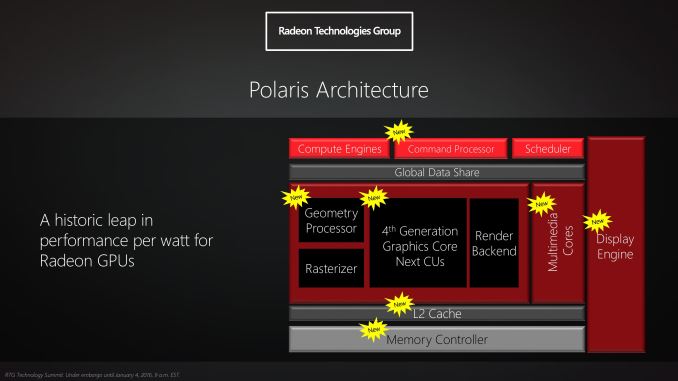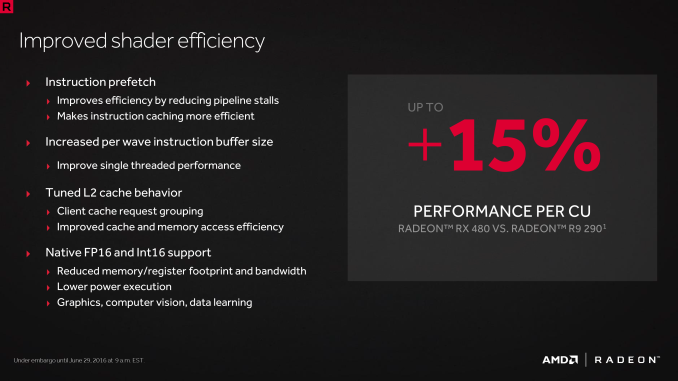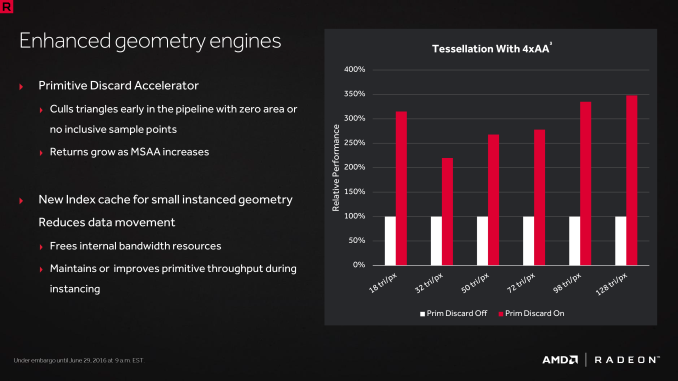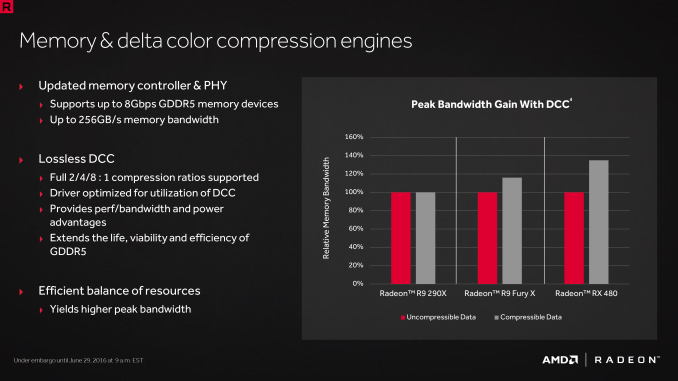The AMD Radeon RX 480 Preview: Polaris Makes Its Mainstream Mark
by Ryan Smith on June 29, 2016 9:00 AM ESTThe Polaris Architecture: In Brief
For today’s preview I’m going to quickly hit the highlights of the Polaris architecture.
In their announcement of the architecture this year, AMD laid out a basic overview of what components of the GPU would see major updates with Polaris. Polaris is not a complete overhaul of past AMD designs, but AMD has combined targeted performance upgrades with a chip-wide energy efficiency upgrade. As a result Polaris is a mix of old and new, and a lot more efficient in the process.
At its heart, Polaris is based on AMD’s 4th generation Graphics Core Next architecture (GCN 4). GCN 4 is not significantly different than GCN 1.2 (Tonga/Fiji), and in fact GCN 4’s ISA is identical to that of GCN 1.2’s. So everything we see here today comes not from broad, architectural changes, but from low-level microarchitectural changes that improve how instructions execute under the hood.
Overall AMD is claiming that GCN 4 (via RX 480) offers a 15% improvement in shader efficiency over GCN 1.1 (R9 290). This comes from two changes; instruction prefetching and a larger instruction buffer. In the case of the former, GCN 4 can, with the driver’s assistance, attempt to pre-fetch future instructions, something GCN 1.x could not do. When done correctly, this reduces/eliminates the need for a wave to stall to wait on an instruction fetch, keeping the CU fed and active more often. Meanwhile the per-wave instruction buffer (which is separate from the register file) has been increased from 12 DWORDs to 16 DWORDs, allowing more instructions to be buffered and, according to AMD, improving single-threaded performance.
Outside of the shader cores themselves, AMD has also made enhancements to the graphics front-end for Polaris. AMD’s latest architecture integrates what AMD calls a Primative Discard Accelerator. True to its name, the job of the discard accelerator is to remove (cull) triangles that are too small to be used, and to do so early enough in the rendering pipeline that the rest of the GPU is spared from having to deal with these unnecessary triangles. Degenerate triangles are culled before they even hit the vertex shader, while small triangles culled a bit later, after the vertex shader but before they hit the rasterizer. There’s no visual quality impact to this (only triangles that can’t be seen/rendered are culled), and as claimed by AMD, the benefits of the discard accelerator increase with MSAA levels, as MSAA otherwise exacerbates the small triangle problem.
Along these lines, Polaris also implements a new index cache, again meant to improve geometry performance. The index cache is designed specifically to accelerate geometry instancing performance, allowing small instanced geometry to stay close by in the cache, avoiding the power and bandwidth costs of shuffling this data around to other caches and VRAM.
Finally, at the back-end of the GPU, the ROP/L2/Memory controller partitions have also received their own updates. Chief among these is that Polaris implements the next generation of AMD’s delta color compression technology, which uses pattern matching to reduce the size and resulting memory bandwidth needs of frame buffers and render targets. As a result of this compression, color compression results in a de facto increase in available memory bandwidth and decrease in power consumption, at least so long as buffer is compressible. With Polaris, AMD supports a larger pattern library to better compress more buffers more often, improving on GCN 1.2 color compression by around 17%.
Otherwise we’ve already covered the increased L2 cache size, which is now at 2MB. Paired with this is AMD’s latest generation memory controller, which can now officially go to 8Gbps, and even a bit more than that when oveclocking.














449 Comments
View All Comments
fanofanand - Wednesday, June 29, 2016 - link
You are commenting on the RX 480 article you are waiting for. Maybe you are looking for a deeper dive, but give em' a break. This is already more in-depth than you will get from 90% of the other review sites.nagi603 - Wednesday, June 29, 2016 - link
So much for an upgrade from a 290X.... it isn't even a side-grade at this point.evolucion8 - Wednesday, June 29, 2016 - link
If it was an upgrade from the 290X, wouldn't be called RX 490 instead?nagi603 - Wednesday, June 29, 2016 - link
No, it would be called 390X then. You know, the 480 is two steps ahead...evolucion8 - Wednesday, June 29, 2016 - link
Wrong, 290X replacement was Fury X, and the 280X replacement was the 390X, the issue with the naming scheme was to make space for the Fury X naming which messed up the whole naming convention. Now they are using it back like on the 200 series days. Its clear that AMD is targeting $200 buyers, not $300+ buyers on the likes of the GTX 970, 980, 390, 390X and so on.WhisperingEye - Thursday, June 30, 2016 - link
Newegg is selling an EVGA 970 ACX 2.0+ for $250 dollars right now. Now which buyers are we targeting again?mikato - Friday, July 29, 2016 - link
Can you spell out your point a little better? And please use a useful comparison... since, you know, I don't think you have one here.Syran - Wednesday, June 29, 2016 - link
Small mistake early on in the article, in listing the specs, it shows the 4GB card with 8GB of vram.Ryan Smith - Wednesday, June 29, 2016 - link
Thanks!watzupken - Wednesday, June 29, 2016 - link
The performance is rather underwhelming to be honest. It may be a little early to conclude with the state of the driver for this new card. Still I feel its kind of just performing at the level of a R9 390 in most cases and is saved by the aggressive pricing.